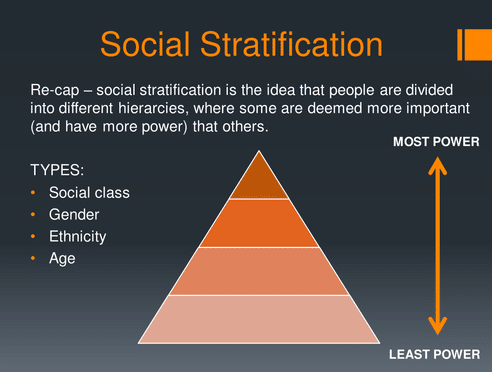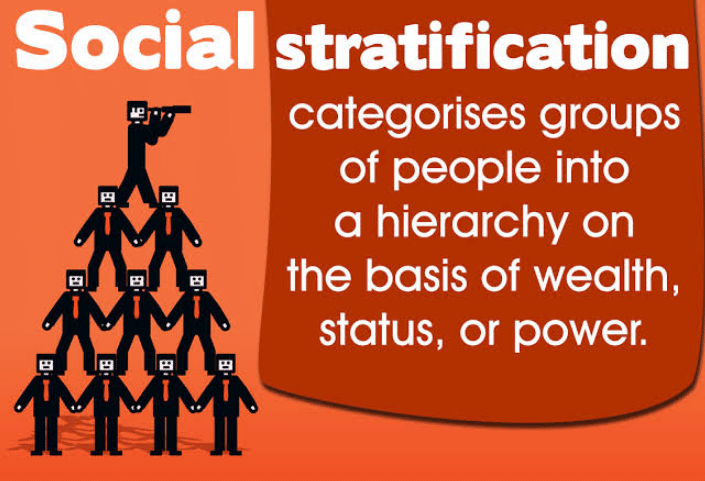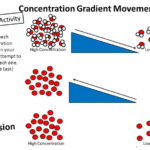Social Stratification: Structural functionalists argue that social inequality plays a vital role in the smooth operation of a society. The Davis-Moore thesis states that social stratification has beneficial consequences for the operation of society. Davis and Moore argue that the most difficult jobs in any society are the most necessary and require the highest rewards and compensation to sufficiently motivate individuals to fill them.
Certain jobs, like mowing grass or cleaning toilets, can be performed by almost anyone, while other jobs, such as performing brain surgery, are difficult and require the most talented people to perform them.Social stratification refers to a system by which a society ranks categories of people in a hierarchy. Let’s examine some of the theories surrounding this concept.

Social Stratification Definition
Social stratification refers to society’s categorization of its people into groups based on socioeconomic factors like wealth, income, race, education, gender, occupation, and social status, or derived power (social and political). As such, stratification is the relative social position of persons within a social group, category, geographic region, or social unit.
In modern Western societies, social stratification is typically defined in terms of three social classes: (i) the upper class, (ii) the middle class, and (iii) the lower class; in turn, each class can be subdivided into, e.g. the upper-stratum, the middle-stratum, and the lower stratum. Moreover, a social stratum can be formed upon the bases of kinship, clan, tribe, or caste, or all four.
The categorization of people by social strata occurs most clearly in complex state-based, polycentric, or feudal societies, the latter being based upon socio-economic relations among classes of nobility and classes of peasants. Historically, whether or not hunter-gatherer, tribal, and band societies can be defined as socially stratified, or if social stratification otherwise began with agriculture and large-scale means of social exchange, remains a debated matter in the social sciences. Determining the structures of social stratification arises from inequalities of status among persons, therefore, the degree of social inequality determines a person’s social stratum. Generally, the greater the social complexity of a society, the more social stratification exists, by way of social differentiation.
What Is Social Stratification
Sociologists use the term social stratification to describe the system of social standing. Social stratification refers to a society’s categorization of its people into rankings of socioeconomic tiers based on factors like wealth, income, race, education, and power.
You may remember the word “stratification” from the geology class. The distinct vertical layers found in rock, called stratification, are a good way to visualize the social structure. Society’s layers are made of people, and society’s resources are distributed unevenly throughout the layers. The people who have more resources represent the top layer of the social structure of stratification. Other groups of people, with progressively fewer and fewer resources, represent the lower layers of our society.

Strata in rock illustrate social stratification. People are sorted, or layered, into social categories. Many factors determine a person’s social standing, such as income, education, occupation, as well as age, race, gender, and even physical abilities. (Photo courtesy of Just a Prairie Boy/Flickr)
In the United States, people like to believe everyone has an equal chance of success. To a certain extent, Aaron illustrates the belief that hard work and talent—not prejudicial treatment or societal values—determine social rank. This emphasis on self-effort perpetuates the belief that people control their own social standing.
However, sociologists recognize that social stratification is a society-wide system that makes inequalities apparent. While there are always inequalities between individuals, sociologists are interested in larger social patterns. Stratification is not about individual inequalities, but about systematic inequalities based on group membership, classes, and the like. No individual, rich or poor, can be blamed for social inequalities. The structure of a society affects a person’s social standing. Although individuals may support or fight inequalities, social stratification is created and supported by society as a whole.
The people who live in these houses most likely share similar levels of income and education. Neighborhoods often house people of the same social standing. Wealthy families do not typically live next door to poorer families, though this varies depending on the particular city and country.
Factors that define stratification vary in different societies. In most societies, stratification is an economic system, based on wealth, the net value of money and assets a person has, and income, a person’s wages, or investment dividends. While people are regularly categorized based on how rich or poor they are, other important factors influence social standing. For example, in some cultures, wisdom and charisma are valued, and people who have them are revered more than those who don’t. In some cultures, the elderly are esteemed; in others, the elderly are disparaged or overlooked. Societies’ cultural beliefs often reinforce the inequalities of stratification.
One key determinant of social standing is the social standing of our parents. Parents tend to pass their social position on to their children. People inherit not only social standing but also the cultural norms that accompany a certain lifestyle. They share these with a network of friends and family members. Social standing becomes a comfort zone, a familiar lifestyle, and an identity. This is one of the reasons first-generation college students do not fare as well as other students.
Other determinants are found in a society’s occupational structure. Teachers, for example, often have high levels of education but receive relatively low pay. Many believe that teaching is a noble profession, so teachers should do their jobs for the love of their profession and the good of their students—not for money. Yet no successful executive or entrepreneur would embrace that attitude in the business world, where profits are valued as a driving force. Cultural attitudes and beliefs like these support and perpetuate social inequalities.
How Is Global Stratification
Since social stratification is the most binding and central concern of sociology, changes in the study of social stratification reflect trends in the entire discipline. The founders of sociology—including Weber—thought that the United States, unlike Europe, was a classless society with a high degree of upward mobility. During the Great Depression, however, Robert and Helen Lynd, in their famous Middletown (1937) studies, documented the deep divide between the working and the business classes in all areas of community life. W. Lloyd Warner and colleagues at Harvard University applied anthropological methods to study the Social Life of a Modern Community (1941) and found six social classes with distinct subcultures: upper upper and lower upper, upper middle and lower middle, and upper lower and lower classes. In 1953 Floyd Hunter’s study of Atlanta, Georgia, shifted the emphasis in stratification from status to power; he documented a community power structure that controlled the agenda of urban politics. Likewise, C. Wright Mills in 1956 proposed that a “power elite” dominated the national agenda in Washington, a cabal comprising business, government, and the military.
From the 1960s to the 1980s, research in social stratification was influenced by the attainment model of stratification, initiated at the University of Wisconsin by William H. Sewell. Designed to measure how individuals attain occupational status, this approach assigned each occupation a socioeconomic score and then measured the distance between sons’ and fathers’ scores, also using the educational achievement of fathers to explain intergenerational mobility. Peter M. Blau and Otis Dudley Duncan used this technique in the study published as The American Occupational Structure (1967).
Attempting to build a general theory, Gerhard Lenski shifted attention to whole societies and proposed an evolutionary theory in Power and Privilege (1966) demonstrating that the dominant forms of production (hunting and gathering, horticulture, agriculture, and industry) were consistently associated with particular systems of stratification. This theory was enthusiastically accepted, but only by a minority of sociologists. Addressing the contemporary world, Marion Levy theorized in Modernization and the Structures of Societies (1960) that underdeveloped nations would inevitably develop institutions that paralleled those of the more economically advanced nations, which ultimately would lead to a global convergence of societies. Challenging the theory as a conservative defense of the West, Immanuel Wallerstein’s The Modern World-System (1974) proposed a more pessimistic world-system theory of stratification. Wallerstein averred that advanced industrial nations would develop most rapidly and thereby widen global inequality by holding the developing nations in a permanent state of dependency.
Different From Social Stratification?
As a result of the Great Recession that rocked our nation’s economy in the last few years, many families and individuals found themselves struggling like never before. The nation fell into a period of prolonged and exceptionally high unemployment. While no one was completely insulated from the recession, perhaps those in the lower classes felt the impact most profoundly. Before the recession, many were living paycheck to paycheck or even had been living comfortably. As the recession hit, they were often among the first to lose their jobs. Unable to find replacement employment, they faced more than loss of income. Their homes were foreclosed, their cars were repossessed, and their ability to afford healthcare was taken away. This put many in the position of deciding whether to put food on the table or fill a needed prescription.
While we’re not completely out of the woods economically, there are several signs that we’re on the road to recovery. Many of those who suffered during the recession are back to work and are busy rebuilding their lives. The Affordable Health Care Act has provided health insurance to millions who lost or never had it.
But the Great Recession, like the Great Depression, has changed social attitudes. Where once it was important to demonstrate wealth by wearing expensive clothing items like Calvin Klein shirts and Louis Vuitton shoes, now there’s a new, thriftier way of thinking. In many circles, it has become hip to be frugal. It’s no longer about how much we spend, but about how much we don’t spend. Think of shows like Extreme Couponing on TLC and songs like Macklemore’s “Thrift Shop.”
Caste systems are closed stratification systems in which people can do little or nothing to change their social standing. A caste system is one in which people are born into their social standing and will remain in it their whole lives. People are assigned occupations regardless of their talents, interests, or potential. There are virtually no opportunities to improve a person’s social position.
In the Hindu caste tradition, people were expected to work in the occupation of their caste and to enter into marriage according to their caste. Accepting this social standing was considered a moral duty. Cultural values reinforced the system. Caste systems promote beliefs in fate, destiny, and the will of a higher power, rather than promoting individual freedom as a value. A person who lived in a caste society was socialized to accept his or her social standing.
Although the caste system in India has been officially dismantled, its residual presence in Indian society is deeply embedded. In rural areas, aspects of the tradition are more likely to remain, while urban centers show less evidence of this past. In India’s larger cities, people now have more opportunities to choose their own career paths and marriage partners. As a global center of employment, corporations have introduced merit-based hiring and employment to the nation.








